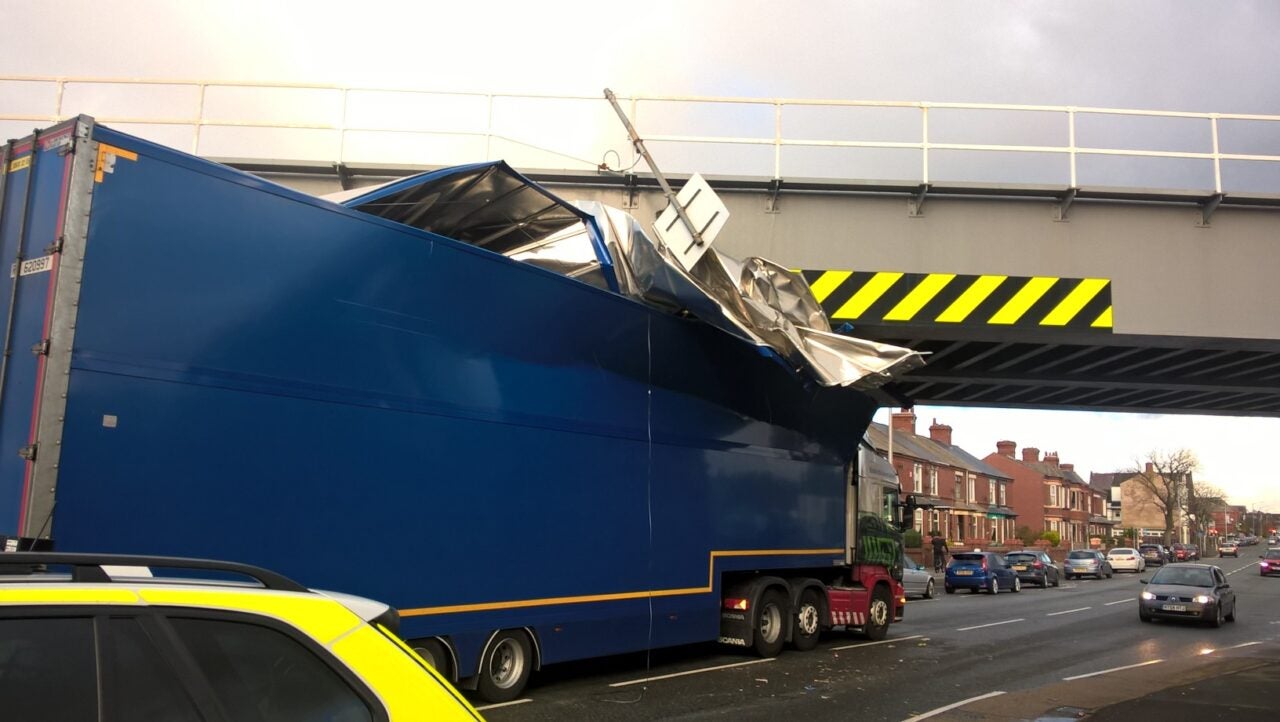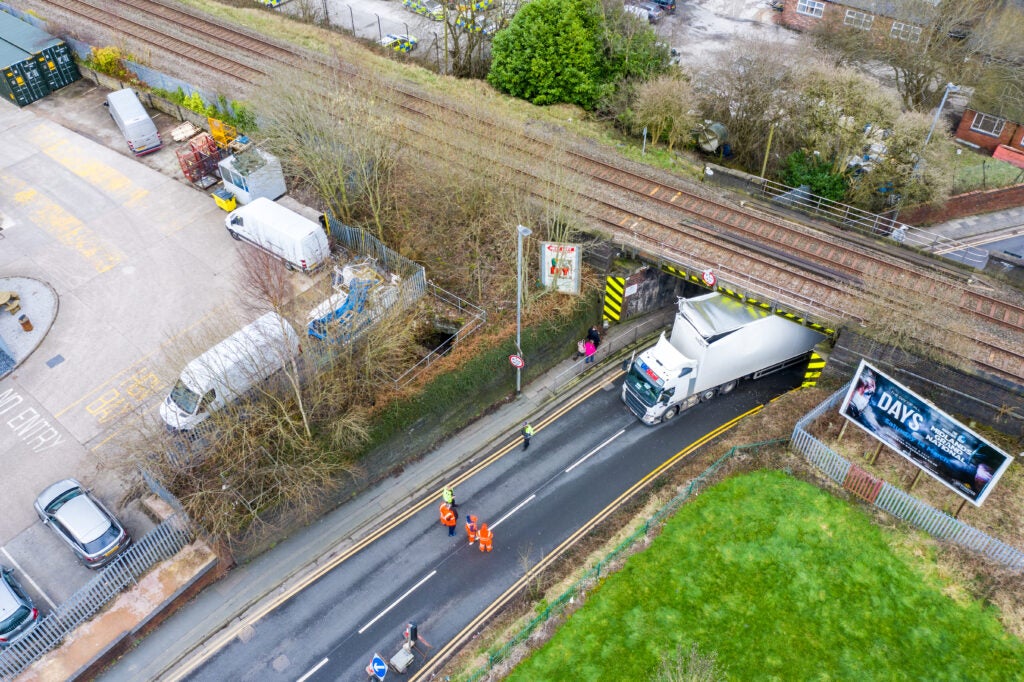
Last year, more than 1,600 rail bridges in the UK were reportedly struck after lorry drivers failed to correctly gauge their clearance. This increasing figure prompted Network Rail to relaunch its ‘Lorries Can’t Limbo’ campaign. Frankie Youd profiles the initiative.
Across the UK, railway bridges have been experiencing some heavy hits as lorry drivers around the country have been colliding with bridge arches after incorrectly gauging clearance levels.

Discover B2B Marketing That Performs
Combine business intelligence and editorial excellence to reach engaged professionals across 36 leading media platforms.
Between 1 April 2020 and 31 March 2021 there were 1,624 bridge strikes reported across the network. These collisions not only create a dangerous situation for road users and train operators, but also result in financial setbacks as repairs take place at an increased rate.
Most of the vehicles that collided with bridges were heavy goods vehicles (HGVs), as well as buses, at a cost of over £13,000 per strike, costing the UK taxpayer around £23m in a year.
Wise up, size up: the campaign relaunch
With the Christmas rush taking place last month, it was predicted that an increased number of large lorries and vehicles would be travelling up and down the roads in the UK – increasing the potential risk of railway bridge collisions.
With this in mind, Network Rail relaunched their ‘Lorries Can’t Limbo’ campaign in November last year. The campaign, which was originally launched in 2018, was created in order to remind drivers and operators of their obligations to prevent bridge strikes from occurring.

US Tariffs are shifting - will you react or anticipate?
Don’t let policy changes catch you off guard. Stay proactive with real-time data and expert analysis.
By GlobalDataThe campaign saw Network Rail collaborating with Highways England and the Drive and Vehicle Standards Agency, to lead a Bridge Strike Prevention Group to provide companies and their employees with the knowledge and tools they need to avoid striking bridges.
Last year alone Network Rail reported that more than £5.5m was paid out in order to compensate for the delays caused by bridge strikes over the year. The organisation also reported that an average of five bridge strikes happen per day, which causes delays of up to two hours for train routes.
The educational campaign, with the slogan ‘Wise Up, Size Up’, aims to remind drivers and haulage operators of the risks bridges can cause, to encourage drivers to check their vehicle and plan their route to avoid low railway bridges where possible, as well as providing companies with educational resources and guidance for drivers and logistics companies to help them tackle bridge strikes.
Campaign aims and goals
“Information is available on the Network Rail website. There are resources that can be used for Certificate of Professional Competence qualifications – these are the modules that the drivers undertake for the professional driver qualifications,” says Yvonne Boyle, national lead for bridge strikes at Network Rail.
“We have information that can be used by transport planners, and we also engaged with the AA and provide information for the truckers Atlas. There’s a whole host of resources that are available.”
The campaign saw Network Rail working alongside some of Britain’s biggest haulage firms, as well as other industry bodies to discuss educational practices and knowledge to reduce the risk of bridge strikes. Working with haulage partners has allowed Network Rail to survey employees, providing the organisation with valuable feedback directly from drivers surrounding this issue.
““Since the collaborative group has been set up, [the bridge at] St. John Street in Litchfield has reduced from 24 strikes from 2019-2020, down to 18 strikes in the period of 2020-2021.”
Research carried out by the campaign team showed that 43% of lorry drivers admitted to not measuring their vehicle before heading out onto the roads, paired with this 52% admitting to not taking low railway bridges into account.
Alongside this, a collaborative group comprised of local authorities, haulage, and the police within the West Midlands – one of the highest recorded areas for bridge strikes – has been set up in order to reduce the number of collisions occurring within the area.
“Since the collaborative group has been set up, [the bridge at] St. John Street in Litchfield has reduced from 24 strikes from 2019-2020, down to 18 strikes in the period of 2020-2021. This is primarily because of this collaborative working with the external agencies and addressing the issues that potentially bridge strikes occurring,” according to Boyle.
“If the signage is poor, there’s a discussion with the local authority and the local authority improves the signage. Or, if there’s vegetation covering it, we ask for it to be cut down. Another area where it has been addressed is the removal of billboards, which are sometimes seen as a distraction on approach to structures. This collaborative working has had a significant degree of success in that area.”

Increasing awareness
In order to promote and draw awareness to the campaign, posters were displayed at points across Britain, including motorway service stations, in a hope that drivers will take this issue into account.
Campaign posters and visual information were publicised on what the organisation referred to as ‘hot spots’ such as truck stops, motorway service stations, fuel nozzles, and in bathrooms at service stations.
This approach aims to engage with the key target audience, revolving around the two principal messages of the campaign, encouraging drivers to know the height of their vehicle as well as planning their routes in advance.
In tandem, Network Rail has gathered a team of bridge strike “champions”, who visit haulage companies to raise awareness and point out local risks that drivers may face around the area.
It is hoped that the re-launch of this campaign will heighten HGV driver awareness on this issue, and that bridge collision figures will decline this year.
You shall not pass: UK railway bridges with the highest number of incidents
So where are these most hit railway bridges? Network Rail has compiled a list of the most battered bridges to further raise awareness to drivers and HGV operators.
| Coddenham Road, Needham Market, Suffolk | 19 strikes |
| St John’s Street, Lichfield, Staffordshire | 18 strikes |
| Harlaxton Road, Grantham, Lincolnshire | 16 strikes |
| Stuntney Road, Ely, Cambridgeshire | 15 strikes |
| Bromford Road Dudley, West Midlands | 13 strikes |
| Watling Street, Hinckley, Leicestershire | 11 strikes |
| Warminster Road, Wilton, Wiltshire | 11 strikes |
| Ipswich Road, Manningtree, Essex | 10 strikes |
| Thames Street, Staines-upon-Thames, Surrey | 10 strikes |
| Lower Downs Road, Wimbledon, London | 10 strikes |





